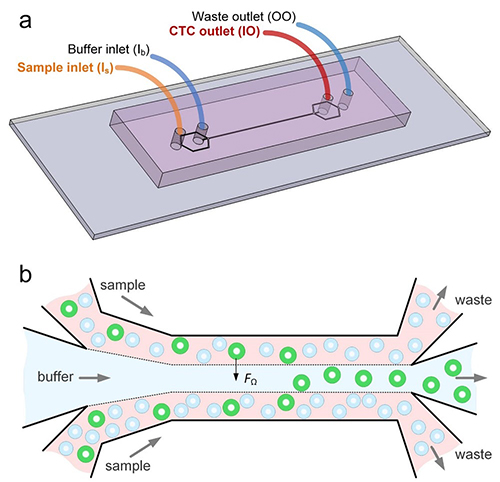Could a fast, cheap, and accurate liquid biopsy diagnostic cancer test soon be available to clinical laboratories and anatomic pathology groups?
What if medical laboratories worldwide could perform a simple liquid biopsy diagnostic test that detected cancer in its various forms? Such a test, if affordable and accurate, would be a boon to histopathology and clinical pathology laboratories. Until now, though, such a test has proven to be elusive. But, researchers at the University of Illinois at Chicago (UIC) and Queensland University of Technology (QUT) in Australia think they may have such a technology in hand.
The researchers unveiled a diagnostic device that uses microfluidic technology to identify cell types in blood by their size. The device also “can isolate individual cancer cells from patient blood samples,” according to a news release.
The ability to isolate circulating tumor cells could enable clinical laboratories to perform diagnostic cancer tests on liquid biopsies and blood samples. Dark Daily reported on various studies involving liquid biopsies—an alternative to invasive and costly cancer diagnostic procedures, such as surgery and tissue biopsies—in previous e-briefings.
The new device differs from other microfluidic technologies that rely on biomarkers to attach to tumor cells (aka, affinity separation), New Atlas reported. Papautsky co-authored a research paper on their findings published in Nature: Microsystems and Nanoengineering.

Searching for ‘Purity’
The UIC and QUT researchers were motivated by the information-rich nature of circulating tumor cells. They also saw opportunity for escalated “purity” in results, as compared to past studies.
In the paper, they acknowledged the work of other scientists who deployed microfluidic technology affinity-based methods to differentiate tumor cells in blood. Past studies (including previous work by the authors) also explored tumor cells based on size and difference from white blood cells.
“While many emerging systems have been tested using patient samples, they share a common shortcoming: their purity remains to be significantly improved. High purity is in strong demand for circulating tumor cell enumeration, molecular characterization, and functional assays with less background intervention from white blood cells,” the authors wrote in their paper.
How the Device Works
The scientists say their system leverages “size-dependent inertial migration” of cells. According to the news release:
- Blood passes through “microchannels” formed in plastic in the device;
- “Inertial migration and shear-induced diffusion” separate cancer cells from blood;
- Tiny differences in size determine a cell’s attraction to a location; and
- Cells separate to column locations as the liquid moves.
In other words, the device works as a filter sorting out, in blood samples, the circulating tumor cells based on their unique size, New Atlas explained.
93% of Cancer Cells Recovered by Device
When the researchers tested their new device:
- Researchers placed 10 small-cell-lung cancer cells into five-milliliter samples of healthy blood;
- The blood was then flowed through the device; and
- 93% of the cancer cells were recovered.
“A 7.5 milliliter tube of blood, which is typical volume for a blood draw, might have 10 cancer cells and 35- to 40-billion blood cells. So, we are really looking for a needle in a haystack,” Papautsky stated in the news release.

“We report on a novel multi-flow microfluidic system for the separation of circulating tumor cells with high purity. The microchannel takes advantage of inertial migration of cells. The lateral migration of cells strongly depends on cell size in our microchannel, and label-free separation of circulating tumor cells from white blood cells is thus achieved without sophisticated sample predation steps and external controls required by affinity-based and active approaches,” the researchers wrote in their paper.
The device could one day aid physicians in precision medicine and the development of targeted treatment plans for patients, reported Genetic Engineering and Biotechnology News.
Other Microfluidic Diagnostic Devices
The researchers plan wider trials and the addition of biomarkers to enable cancer DNA detection, New Atlas reported, which described the UIC/QUT study as part of a “new wave of diagnostics.”
Another novel liquid biopsy approach to cancer detection is under development at the University of Queensland. It involves a unique nano-scale DNA signature that appeared in breast cancer and other cancer studies. (See, “University of Queensland Researches May Have Found a Universal Biomarker That Identifies Cancer in Various Human Cells in Just 10 Minutes!” Dark Daily, May 20, 2019.)
And researchers developed a “labyrinth” label-free microfluidic device that enabled white blood cells and circulating tumor cells to separate during a study at the University of Michigan. (See, “University of Michigan Researchers Use ‘Labyrinth’ Chip Design in Clinical Trial to Capture Circulating Tumor Cells of Different Cancer Types,” Dark Daily, February 2, 2018.)
With so much focus on liquid biopsy research, it may be possible for medical laboratories to one day not only diagnose cancer through blood tests, but also to find the disease earlier and in a more precise way than with traditional tissue sample analysis.
—Donna Marie Pocius
Related Information:
New Microfluidic Device Can Detect Cancer Cells in Blood
Microfluidic Device Promises Cheap and Fast Detection of Cancer Cells in Blood
Liquid Biopsies Become Cheap and Easy with New Microfluidic Device



